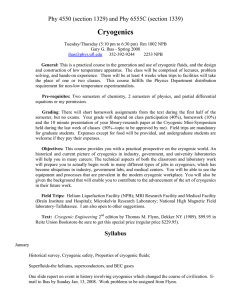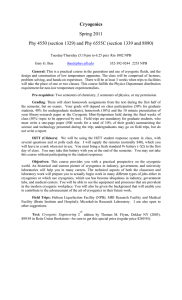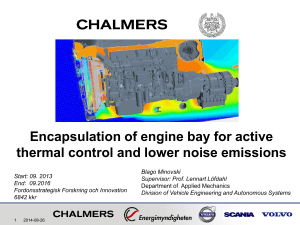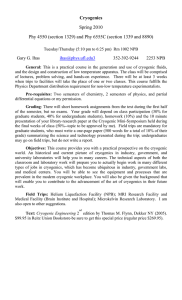Cryogenics Symposium Evaporate Cooling 2/26/2011 Day 1 – Thursday March 31, 2011
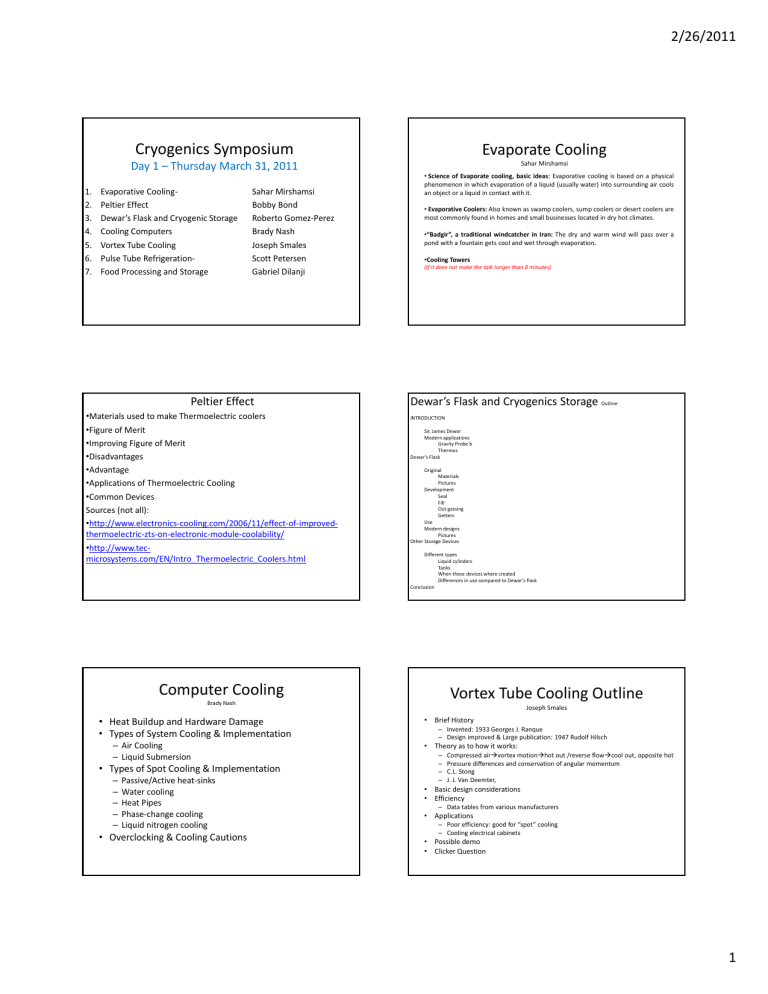
Cryogenics
Symposium
Day
1
– Thursday
March
31,
2011
1. Evaporative Cooling ‐
2. Peltier Effect
Sahar Mirshamsi
Bobby Bond
3. Dewar’s Flask and Cryogenic Storage Roberto Gomez ‐ Perez
4. Cooling Computers Brady Nash
5. Vortex Tube Cooling
6. Pulse Tube Refrigeration ‐
7. Food Processing and Storage
Joseph
Scott
Gabriel
Petersen
Smales
Dilanji
Evaporate
Cooling
Sahar Mirshamsi
• Science of Evaporate cooling, basic ideas : Evaporative cooling is based on a physical phenomenon in which evaporation of a liquid (usually water) into surrounding air cools an object or a liquid in contact with it.
• Evaporative Coolers: Also known as swamp coolers, sump coolers or desert coolers are most commonly found in homes and small businesses located in dry hot climates.
• “Badgir”, a traditional windcatcher in Iran: The dry and warm wind will pass over a pond with a fountain gets cool and wet through evaporation .
• Cooling Towers
(If it does not make the talk longer than 8 minutes)
2/26/2011
• Materials used to make
Peltier Effect
Thermoelectric
Cooling
Outline
• Figure of Merit
• Improving Figure of Merit
Bobby
Bond
• Disadvantages
• Advantage
• Applications of Thermoelectric Cooling
• Common Devices
Sources (not all):
• http://www.electronics
‐ cooling.com/2006/11/effect ‐ of ‐ improved ‐ thermoelectric ‐ zts ‐ on ‐ electronic ‐ module ‐ coolability/
• http://www.tec
‐ microsystems.com/EN/Intro_Thermoelectric_Coolers.html
Dewar’s
Flask
and
Cryogenics
Storage
Outline
INTRODUCTION
Sir.
James Dewar
Modern applications
Gravity Probe b
Thermos
Dewar’s Flask
Original
Materials
Pictures
Development
Seal
Fill
Out gassing
Getters
Use
Modern designs
Pictures
Other Storage Devices
Different types
Liquid cylinders
Tanks
When these devices where created
Differences in use compared to Dewar’s flask
Conclusion
Computer
Cooling
Brady Nash
• Heat Buildup and Hardware Damage
• Types of System Cooling & Implementation
– Air Cooling
– Liquid Submersion
• Types of Spot Cooling & Implementation
– Passive/Active heat ‐ sinks
– Water cooling
– Heat Pipes
– Phase ‐ change cooling
– Liquid nitrogen cooling
• Overclocking & Cooling Cautions
Vortex
Tube
Cooling
Outline
Joseph Smales
• Brief History
– Invented: 1933 Georges J.
Ranque
– Design improved & Large publication: 1947 Rudolf Hilsch
• Theory as to how it works:
– Compressed air vortex motion hot out /reverse flow cool out, opposite hot
– Pressure differences and conservation of angular momentum
– C.L.
Stong
– J.
J.
Van Deemter,
• Basic design considerations
• Efficiency
– Data tables from various manufacturers
• Applications
– Poor efficiency: good for “spot” cooling
– Cooling electrical cabinets
• Possible demo
• Clicker Question
1
pulse
tube
refrigeration
Slide 1: Introduction
Basic overview of pulse tube refrigeration
How it uses acoustics and involves no cold moving parts
Slide 2: Beginning Research
NASA origins for space applications: lower mass and longer life
Originally abandoned due to discouraging results
Phase shift discovery opened topic back up
Slide 3: Picture Description
Using a picture of a pulse tube refrigerator, I’ll go over the components of the diagram
How it is a Stirling ‐ type
Slide 4: Individual Components
Compressed gas traveling through system
Explain regenerator and heat exchangers
Slide 5: Comparison to other refrigerators
No need for displacer
Efficient (very little interferences)
Can only reach temperatures around 1 K
Slide 6: Current Uses
Very popular in space applications (telescopes)
Ben and Jerry’s interest in thermoacoustics
Semiconductor fabrication
Slide 7: Future possibilities
Most effective at very low temperatures (not good for room temperature applications)
Combining dilution refrigerators and pulse tubes can achieve milli and micro K temperatures without prohibitive cost
Infrared detection, telecommunication filters
Food
Processing
and
Storage
Gabriel
Dilanji
• To
be
continued
2/26/2011
Cryogenics
Symposium
Day
2– Tuesday
April
5,
2011
1. Superfluidity
2. SuperSolid
3. Vortex State ‐ type II superconductors
4. Superconducting Magnets
5. Nuclear Demagnetization Cooling
6. CDF Cryo System
7. Quantum Computing
Kristin Zych
Icon Mazzaccar
Joshua Arlund
Lana Muniz
Roman Ciapurin
Matt Snowball
Adam Butler
Superfluidity Outline
Discovery
‐ when, by whom
Properties
‐ lambda point, viscosity
Theory
‐ Bose/Fermi statistics
Applications
‐ superconductors
Recent developments
‐ supersolids
•
•
•
•
–
What is a supersolid and what are its characteristics?
Motivation for the existence of a supersolid.
“Speculations on Bose ‐ Einstein
Condensation and Quantum
Crystals” by G.V.
Chester, Phys Rev.
A (1970)
–
–
How is it possible to measure supersolidity?
Torsional Oscillator
What would signal its existence within the data?
–
Kim and Chan’s experimental data confirming the existence
“Probable observation of a supersolid helium phase” by Kim and Chan, Nature (2004)
Supersolids
• Controversy over experimental data
– Certain processes eliminate the characteristics that signaled supersolidity
– Experimental data that support its nonexistence
• Alternate explanation for what is occurring at low temperatures
• Chan and Kim’s reaction to experimental data against their case
• Future for Supersolids?
– Possibilities in optical lattices
– “Dynamical Creation of a Supersolid in Asymmetric Mixtures of Bosons”,
Phys Rev.
Letters (2009)
– Maybe it does not exist at all.
Vortex State in type 11 superconductors
What is a superconductor
Type I and type II differences transition (sharp or gradual) penetrating magnetic field
What is the vortex state penetrating flux lines vortex supercurrents
Core size how many are present distribution
Uses of vortex states
2
Superconducting Magnets – Outline
Introduction – What is a superconducting magnet?
History – Heike Kamerlingh Onnes, GeorgeYntema, and type-II superconductors
Materials and Operation – How a superconducting magnet works. Persistent mode.
Advantages/Disadvantages – Comparison to regular magnets.
Applications
- MRI/NMR
- Paricle Accelerators
Nuclear
Demagnetization
• History, what is it, temperature ranges
• Magnetism in materials
• Principles: entropy cycle (main focus)
• Nuclear vs paramagnetic salts
• Laboratory setup (main focus)
• Limitations, external fields, H/T
• Multiple stages, improved technologies
2/26/2011
CDF
Cryo System
Outline
• What is CDF
• Where is it?
What does it do?
• Why does it need to be cold?
• How cold does it get?
• Cryo Systems
• What are the main components?
• Where is the helium stored?
• What is the refrigeration cycle used?
• Refrigerator diagram
• Heat exchange system
• Expansion Engine used, how fast is it?
• Liquefaction of Helium
• How do they monitor the system?
• How do they measure temperature in the system?
• Controlling the system
Snowball
Cryogenics
Symposium
Day
3– Thursday
April
7,
2011
1. Laser Cooling of Solids
2. A short introduction to BEC
3. Solitons in BEC
4. Sperm/Egg Preservation
5. Cryo ‐ Surgery
6. Cryo ‐ Ablation
Pedro Quintero
Xiaochang Miao
Yitzak Calm
Alessa Bastron
Niresh Shukla
Peter Boulos
•
•
•
•
•
Quantum
Computing
What is quantum computing
– How is it different from regular computers
Quantum bit •
•
•
Quantum Gates
Quantum Circuits
– Why is it better
•
•
•
Faster
Capable of modeling quantum systems
Quantum Cryptography
• http://www.cs.rice.edu/~taha/te aching/05F/210/news/2005_09_
16.htm
• http://www.nytimes.com/2010/1
1/09/science/09compute.html
• Quantum Computing by Jozef
Gruska
History of Quantum Computing
– Feynman
– Shor’s factorization algorithm
Why Cryogenics
• http://plato.stanford.edu/entries
/qt ‐ quantcomp/#Rel
– Needs to be superconducting
– Only exhibits quantum behavior near absolute zero
Obstacles
– Error Correction
– Decoherence
– Hardware architecture
• Nuclear Magnetic Resonance
Future of Quantum Computing
– Progress is being made
• Currently there are computers that use a few qubits, within a few years, the number of qubits is expected to increase significantly
Laser
cooling
of
solids
1. History
2. Anti-Stokes fluorescence
3. Basic Principles
4. Experimental Setup
5. Cryocooler Applications
[ 1] S.A.
Egorov and J.L.
Skinner, On the theory of multiphonon relaxation rates in solids, J.
Chem.
Phys.
103 , 1533 (1995).
3
A
short
introduction
to
BEC
1. What’s
Bose
‐
Einstein
Condensation?
(2
slides)
2. How
to
experimentally
realize
BEC?
a.
magnetic
trap
(1
slide) b.
cooling
method
(2
slides)
3. Brief
history
of
BEC
(1
slide)
4. Future
Applications
(1
slide)
Solitons in BEC
February 20, 2011
Yitzi Calm
1. Title: Propagation of Waves in BEC
2. What is a BEC?
3. what is a wave?
what is a soliton?
4. Techniques at ultra low temperatures
1. magnetic trap
2. evaporative cooling
3. laser cooling
Waves and solitons in BEC:
5.
M.
R.
Andrews et al .
Phys.
Rev.
lett.
79 , 553 (1997)
6.
C.
Becker et al .
Nature Phys.
4 , 496 (2008)
7.
I.
Shomroni et al .
Nature Phys.
5, 193 (2009)
8. Conclusion: Physics!
#1!
Yeah!
Sperm/Egg
Preservation
Outline
‐
Bastron
I.
History of sperm/egg cryopreservation
II. Various methods of preservation (slow freezing, vitrification, vapour freezing, etc.))
III. Different cryoprotectants (Pros/Cons)
IV. Freezing and thawing (time/method) results
V. Effects of preservation (vitality, mobility, defects)
VI. New discovery/developments such as virus removal during freezing (HIV, hepatitis, etc)
(SOME OF THE OBOVE TOPICS WILL REQUIRE MULTIPLE SLIDES,
THAT’S WHY THERE ARE ONLY 6)
Cryosurgery - Outline
• What is Cryosurgery? Using cold temperatures to kill harmful cells or abnormal tissue
• What does Cryosurgery treat? Different types of cancerous and precancerous conditions, including: liver cancer, prostate cancer, cervical cancer, and tumors of the bone, among many others
• Equipment: ultrasound, computed tomography, MRI, cryoprobe, bronchoscope, sterile procedure room
• How does it work? Liquid Nitrogen or argon gas is circulated through a cryoprobe, which is placed in contact with the tumor
– Either ultrasound , CT, or MRI is used to guide probe
• Possible side effects: depends on area being treated, but can include loss of fertility, scarring, nerve damage, impotence, incontinence
• Advantages: less invasive, pain and bleeding minimized, cost, less destruction of healthy tissue, can be used on patients who can’t have surgery or radiation therapy
• Disadvantages: uncertainty of long term effectiveness, can only treat cancer that is localized and has not spread
• Future? Still a relatively young technology, thus further studies are necessary to determine long term effectiveness and effective with other types of treatment
• Sources: http://www.cancer.gov/cancertopics/factsheet/Therapy/cryosurgery http://www.livercancer.com/treatments/cryosurgery.html
http://www.radiologyinfo.org/en/info.cfm?pg=cryo
2/26/2011 cryoablation
Slide 1 ‐ Define cryoablation
Slide 2 ‐ Different uses for cryablation/advantages of use
Slide 3 ‐ Diagram of cryoablation clinical set ‐ up
Slide 4 ‐ The function of the apparatus and required equipment
Slide 5 ‐ Cell response to cryoablation
Slide 6 ‐ Cell response to cryoablation
Slide 7 ‐ Cell response to cryoablation
Slide 8 ‐ Cell response to cryoablation
Slide 9 ‐ Video of cryoablation
Slide 10 ‐ Cryoablation in the news
Slide 11 ‐ Past/further studies
Slide 12 ‐ Sources
Cryogenics
Symposium
Day
4
– Tuesday
April
12,
2011
1. Liquefied Natural Gas
2. Cryogenics in SABRE Engine
3. Cryogenic Propellants for Space Vehicles
4. Cryogenics Helping the Military
5. Cryote Project
6. Cryo ‐ Chilldown
Benjamin Bobrof
Jason Christopher
Darsa Donelan
Glenn Mendez
Dylan Fitzpatrick
Dan Zhoa
4
2/26/2011
Liquefied
General
Information
Liquefication
Transportation
Sale
Environmental
Issues
Safety
Treatment
Technology
Natural
Gas
Cryogenic Propellants for Space Launch
Vehicles
• Flight performance
Space flight
Effect of propulsion system
Flight vehicles
Flight stability
• Liquid propellant rocket engine fundamentals
Types of propellants
Tanks and feed systems
Rocket and engines
Valves and pipelines
• Liquid propellants
Propellant properties
Liquid oxidizers, fuels, and monopropellants
Gelled and gaseous propellants
•
Liquid propellant combustion and its stability
Combustion process
Analysis and simulation
Combustion instability
• SpaceX mission – Falcon 9
– Cryogenics
in
the
SABRE
Engine
Symposium Outline – Jason Christopher
Title Slide – Cryogenics in the SABRE Engine
Overview
History
History
Design of SABRE Engine
Pre ‐ Cooler
Compressor
Helium Loop http://industries ‐ news.blogspot.com/2010/07/air engines ‐ and ‐ ramjet.html
http://www.reactionengines.co.uk/sabre.html
Pre ‐ cooling idea started in 1950’s along with liquid air cycle engines (LACE)
Details of how system was designed to work
HOTOL engine was simpler than LACE engine
Problems with patents and the Official Secrets Act led to creation of SABRE
Design of SABRE Engine
Not a rocket or jet engine
Pre ‐ cooled turbo rocket; burns air, liquid oxygen, and hydrogen
Pre ‐ Cooler
Compression of supersonic/hypersonic airflow creates incredible heat as it enters engine
Heavy metals can’t be used as in normal jet engines to cool incoming air
Liquid helium loop cools air from 1000 C to ‐ 140 C in SABRE engine
Compressor
SABRE compressor similar to conventional jet engine compressors
‐ breathing ‐
The low air temperature from the pre ‐ cooler allows compressor to function at very high pressure ratios
Driven by gas turbine from waste heat collected from helium loop
Helium Loop
Warmed helium from pre ‐ cooler and combustion chambers recycled through heat exchanger with liquid hydrogen
Brayton ‐ cycle engine
Used to cool critical parts and also powers miscellaneous parts of the engine as well
Conclusion
History
Design of SABRE Engine
Pre ‐ Cooler
Compressor
Helium Loop
!
Cryogenics:
helping
our
armed
Glenn Mendez
Title
!
Cryogenics: helping our armed forces
• Note, a working title
Who is in charge of the cryogenics?
!
MM ‐ 4201 Cryogenics Technician
# Requirements
# Responsibilities
!
MM ‐ 4283 High and Low Pressure Cryogenic Technician
# Requirements
# Responsibilities
!
Interview with an MM ‐ 4201 or MM ‐ 4283
Why do we need cryogenics in the armed forces?
!
Liquid Hydrogen and Oxygen Used as propellants
# Explain how they work
# Explain where they are used
!
Liquid Oxygen and Nitrogen used as breathing Oxygen for fighter pilots
# Explain how they work
!
Clicker Question
!
Acknowledgements
forces
Cryote
‐
Pages
and
topics
for
discussion
(some bullets will have more than one page).
• What is CRYOTE?
– Will detail the proposed mission as per the published Micro ‐ gravity Cryogenic Experiment
Opportunity article.
– Who is involved?
I will briefly discuss the United Launch Alliance, Innovative Engineering Solutions,
NASA, and etc.
• The benefits of completing the CRYOTE mission.
– Outline what scientists will gain from this mission as opposed to the terrestrial testing.
– Possible further space exploration with fueling depots ,and cost effectiveness in future space transportation.
– Outline some of the multiple studies looking to tag along with the CRYOTE mission.
• Possible CRYOTE stoppers.
– Funding for the ‘space depots’ will not be a critical path.
– Non shuttle derived launch vehicles are hard to get political support.
• The microgravity team at UF and our proposed research.
– Briefly discuss what our team proposed – analyze the cryogenic chilldown rates in reduced gravity.
[1] Wollen, Mark A., Mari Gravlee, Wesley Johnson.
Cryogenic Orbital Testbed (CRYOTE) On ‐ track for Ground and Potential Launch .
“CPIAC Bulletin” Vol.
36, No.4.
July 2010.
Testing
[2] Gravlee Mari, Chris Vera, Mark Wollen, et al.
Micro ‐ gravity Cryogenic Experiment Opportunity .
AIAA SPACE 2010
Conference & Exposition.
30 August – 2 September 2010.
AIAA 2010.
[3] Gravlee Mari, Bernard Kutter, Mark Wollen, et al.
CRYOTE (Cryogenic Orbital Testbed) Concept.
Proposal.
2009.
[4] …more to come… (there are plenty).
I’ve actually been talking with Wesley Johnson from [1] for our reduced gravity experiment, and just recently realized he co ‐ authored an article on the CRYOTE mission.
I have emailed him in hopes of finding still more sources.
CHILLDOWN PROCESS OF CRYOGENIC TRANSPORT LINES IN REDUCED
GRAVITY
Brief overview
Background
Previous research
Current test objectives
System description
Equipment
Structural analysis
Experiment & Procedure
Safety/hazard analysis
Data & Analysis
Analysis procedure
Expected results
5
Cryogenics
Symposium
Day
5
– Thursday
April
14,
2011
1. Cryogenics for Telescopes
2. HTC SC Power Transmission Lines
3. Cooling CMS
4. Cryo ‐ Grinding
5. Cryo ‐ Cleaning
6. Cryo ‐ Hazards/Safety
Justin Hugon
Marcus Peprah
Mohammed Zakaria
Zachary Roberts
Luronne Vaval
Adam Sandwell
Cryogenics
for
Telescopes
Justin Hugon
Why use cryogenics on telescopes?
Cryogenic Telescopes In Space
– Infrared Astronomy
• Necessity of Low Temperatures
• Instrumentation
– Gamma Ray Spectrometers
• Instrumentation
Future Cryogenic Gravitational Wave Telescopes
– Merits
– Challenges
Cryogenics Symposium, Spring 2011
High
Temperature
Superconductors
in
Power
Technology
Outline
• High Tc Superconductors (HTS)
• What are they?
• Examples and Uses [focus on electric power usage]
• Power distribution cables
• Magnetic ‐ energy storage devices
• Fault Current Limiters
• HTS In Electric Power Distribution
• Materials and conditions for power technology
• Structure of an HTS Cable
• Advantages and Disadvantages of HTS in power applications
• Summary
2/26/2011
Cryogenic
Grinding!
Part 1: What is cryogenic grinding?
Part 2: What does cryogenic grinding do for materials?
‐ How it differs from normal grinding
‐ Cryomilling
Part 3: What kind of materials is it used for?
‐ Thermoplastics
‐ Soft Materials
‐ Elastomers
Part 4: Conclusion
Cryo Cleaning
‐
Dry
Ice
Blasting
• About dry ice
– Manufacturing
– Demo(possibly)
• History of dry ice cleaning
– Early beginnings
– Where it is today
• How it works
– Methods of cleaning
– How the cleaning works
• Equipment
– Single hose technology
– Two hose technology
• Uses of dry ice cleaning today
– Companies
– What dry ice cleaning is used on
• Benefits of dry ice cleaning
– Economic and environmental benefits
• Safety hazards
6
Cryogenic Hazards
Adam Sandwell
•Low Temperature (duh)
•Liquid range of plethora of cryogens
•Effect of such temperatures on human bodies
•Effect of such temperatures on equiptment
•Flammability
•Hydrogen
•Methane
•Natural Gas
•Asphyxiation
•Rapid Expansion
•Pressure Buildup Due to Solids
•Oxygen
•Supports combustion
•Boompics
•Environmental Impact
•Toxicity
•Atmospheric Impact
•Laws & Regulations
•Transport
•Use
•Acquisition

